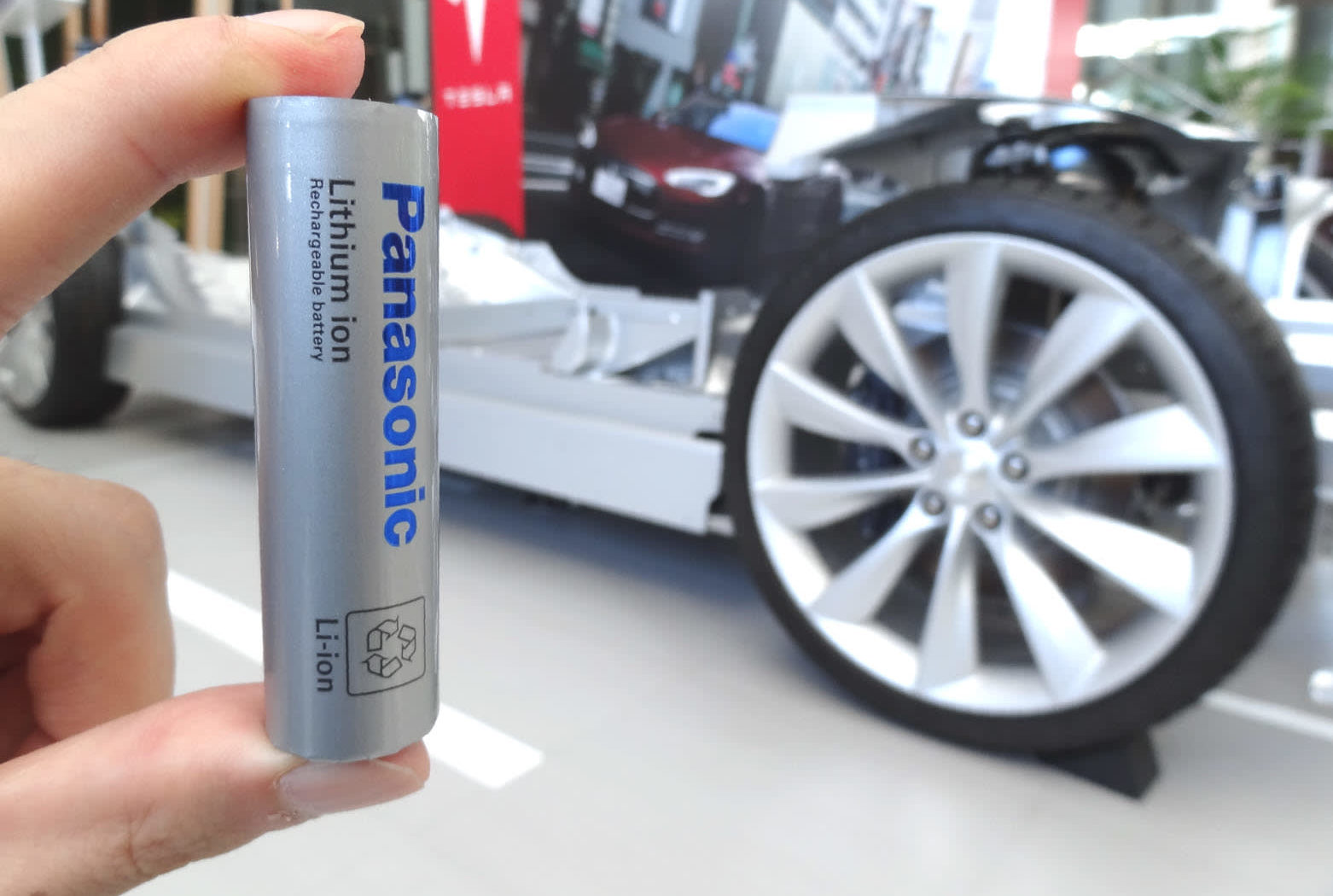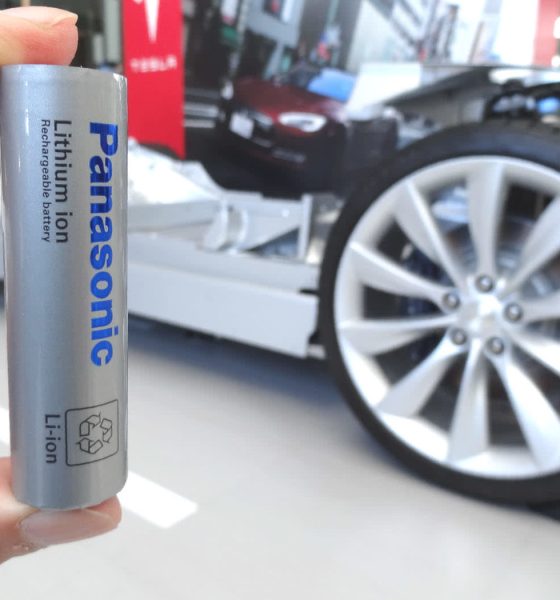

Energy
Panasonic slumps as Tesla branches out with new battery deal
Japanese battery maker Panasonic’s appears to be feeling the direct effects of its partnership with California-based electric car maker Tesla. Just recently, Panasonic opted to cut its profit outlook for 2019 over China’s slowing economy due to the trade war against the United States. Amidst these headwinds, Panasonic’s partnership with Tesla proved to be a silver lining for the Japanese company, pushing its battery business towards profitability — the first time in three quarters.
During a briefing about its adjusted forecasts, Panasonic Chief Financial Officer Hirokazu Umeda pointed out that there have been improvements with sales and profit on its battery business over the past months. Umeda notes that much of these improvements are due to its partnership with Tesla, especially considering the upgrades that Panasonic rolled out to its battery cell lines in Gigafactory 1. Overall, Tesla’s business gave Panasonic an operating profit of 16.5 billion yen (around $150M).
“Sales and profit at the Tesla business have improved,” Umeda said, later adding that additional lines at Gigafactory 1 would be installed by the end of March. The Panasonic CFO noted that with the upcoming improvements, Gigafactory 1’s total capacity could reach 35 GWh.
While its battery business appears to be thriving under its partnership with Tesla, Panasonic’s shares were walloped on Tuesday nonetheless. The Japanese firm’s 6.5% decline on Tuesday transpired amidst news that Tesla is acquiring ultracapacitor firm Maxwell Technologies in an all-stock deal valued at around $218 million. Considering that the opportunities presented by the Maxwell acquisition are related to Tesla’s battery technology, one could almost assume that Panasonic is practically losing its exclusivity as the electric car maker’s sole battery provider.
That said, industry analysts from Japan have noted that Panasonic’s recent decline in the market is primarily due to the company’s bleak quarterly earnings and annual profit estimate, which featured a 9% cut in its operating profit outlook and a decline of 19% for Q4 2018. This was a point highlighted by Masahiko Ishino, an analyst from the Tokai Tokyo Research Center, who noted in a statement to Reuters that Panasonic’s dive in the market was mostly due to the company’s outlook.
“The latest earnings have revealed how tough the situation is for Panasonic,” he said.
In a way, both Tesla and Panasonic appear to be branching out in their respective battery endeavors. Apart from acquiring Maxwell and its ultracapacitor tech, Tesla is also reportedly looking to partner with local battery suppliers in China for vehicles that will be produced at Gigafactory 3. On the other hand, Panasonic appears to be doing the same thing, recently teaming up with Toyota Motor Corp to collaborate in the development and production of rectangular-shaped prismatic batteries. Panasonic is also hoping to supply prismatic batteries to carmakers such as Honda, using the technology it would be developing with Toyota.
While these updates from Tesla and Panasonic might give the impression that the two companies are starting to diverge from each other, such an idea would be inaccurate. The batteries for Tesla’s electric cars and energy storage devices built in the US, after all, are still exclusively supplied by Panasonic. That means that the Japanese company would still be heavily invested in Tesla, as the electric car maker continues the Model 3 ramp and as it raises the production of its energy products like the Powerwall 2. Considering Tesla’s product roadmap, there is a very good chance that the electric car maker’s partnership with Panasonic would last for a long time to come.

Energy
Tesla starts hiring efforts for Texas Megafactory
Tesla’s Brookshire site is expected to produce 10,000 Megapacks annually, equal to 40 gigawatt hours of energy storage.

Tesla has officially begun hiring for its new $200 million Megafactory in Brookshire, Texas, a manufacturing hub expected to employ 1,500 people by 2028. The facility, which will build Tesla’s grid-scale Megapack batteries, is part of the company’s growing energy storage footprint.
Tesla’s hiring efforts for the Texas Megafactory are hinted at by the job openings currently active on the company’s Careers website.
Tesla’s Texas Megafactory
Tesla’s Brookshire site is expected to produce 10,000 Megapacks annually, equal to 40 gigawatt hours of energy storage, similar to the Lathrop Megafactory in California. Tesla’s Careers website currently lists over 30 job openings for the site, from engineers, welders, and project managers. Each of the openings is listed for Brookshire, Texas.
The company has leased two buildings in Empire West Business Park, with over $194 million in combined property and equipment investment. Tesla’s agreement with Waller County includes a 60% property tax abatement, contingent on meeting employment benchmarks: 375 jobs by 2026, 750 by 2027, and 1,500 by 2028, as noted in a report from the Houston Business Journal. Tesla is required to employ at least 1,500 workers in the facility through the rest of the 10-year abatement period.
Tesla’s clean energy boom
City officials have stated that Tesla’s arrival marks a turning point for the Texas city, as it highlights a shift from logistics to advanced clean energy manufacturing. Ramiro Bautista from Brookshire’s economic development office, highlighted this in a comment to the Journal.
“(Tesla) has great-paying jobs. Not just that, but the advanced manufacturing (and) clean energy is coming to the area,” he said. “So it’s not just your normal logistics manufacturing. This is advanced manufacturing coming to this area, and this brings a different type of job and investment into the local economy.”
Energy
Tesla and Samsung SDI in talks over new US battery storage deal: report
The update was related by industry sources and initially reported by South Korean news outlets.

Recent reports have suggested that Tesla and Samsung SDI are in talks over a potential partnership to supply batteries for large-scale energy storage systems (ESS).
The update was related by industry sources and initially reported by South Korean news outlets.
ESS batteries to be built at Samsung’s Indiana plant
As noted in a report from Korea JoongAng Daily, the demand for energy storage systems has been growing rapidly in North America, thanks in no small part to the surge in AI investments across numerous companies. With this in mind, Tesla has reportedly approached Samsung SDI about a potential battery supply deal.
The deal is reportedly worth over 3 trillion Korean won (approximately $2.11 billion) and will span three years, according to The Korea Global Economic Daily. A battery supply deal with Samsung SDI could make sense for Tesla as the company already has a grid-scale battery, the Megapack, which is perfect for industrial use. Samsung SDI could simply supply cells for the EV maker.
Production of the batteries would reportedly take place at Samsung SDI’s joint venture factory with Stellantis in Indiana, which is currently under construction. Samsung SDI recently announced plans to use part of that plant’s EV lines to produce cells for ESS, with a targeted capacity of 30 GWh by the end of next year.
Tesla and Samsung’s partnership
At present, only a handful of manufacturers, including Korea’s LG Energy Solution, Samsung SDI, SK On, and Japan’s Panasonic, are capable of producing energy storage-scale batteries domestically in the United States. A Samsung SDI official issued a comment about the matter, stating, “Nothing has been finalized regarding cooperation with Tesla.”
The possible energy storage system deal adds another layer to Tesla’s growing collaboration with Samsung, which is already in line as a partner in the upcoming production of Tesla’s AI5 and AI6 chips. Early sample manufacturing of the AI6 is expected to begin in South Korea, with mass production slated for Samsung’s Texas-based Taylor foundry when it starts operations.
The AI6 chip will power Tesla’s next wave of high-volume projects, including the Optimus humanoid robot and the autonomous Cybercab service. Musk has called the partnership with Samsung a “real collaboration,” adding that he personally plans to “walk the line” at the Taylor facility to speed up progress.
Energy
Tesla VP hints at Solar Roof comeback with Giga New York push
The comments hint at possible renewed life for the Solar Roof program, which has seen years of slow growth since its 2016 unveiling.

Tesla’s long-awaited and way underrated Solar Roof may finally be getting its moment. During the company’s Q3 2025 earnings call, Vice President of Energy Engineering Michael Snyder revealed that production of a new residential solar panel has started at Tesla’s Buffalo, New York facility, with shipments to customers beginning in the first quarter of 2026.
The comments hint at possible renewed life for the Solar Roof program, which has seen years of slow growth since its 2016 unveiling.
Tesla Energy’s strong demand
Responding to an investor question about Tesla’s energy backlog, Snyder said demand for Megapack and Powerwall continues to be “really strong” into next year. He also noted positive customer feedback for the company’s new Megablock product, which is expected to start shipping from Houston in 2026.
“We’re seeing remarkable growth in the demand for AI and data center applications as hyperscalers and utilities have seen the versatility of the Megapack product. It increases reliability and relieves grid constraints,” he said.
Snyder also highlighted a “surge in residential solar demand in the US,” attributing the spike to recent policy changes that incentivize home installations. Tesla expects this trend to continue into 2026, helped by the rollout of a new solar lease product that makes adoption more affordable for homeowners.
Possible Solar Roof revival?
Perhaps the most intriguing part of Snyder’s remarks, however, was Tesla’s move to begin production of its “residential solar panel” in Buffalo, New York. He described the new panels as having “industry-leading aesthetics” and shape performance, language Tesla has used to market its Solar Roof tiles in the past.
“We also began production of our Tesla residential solar panel in our Buffalo factory, and we will be shipping that to customers starting Q1. The panel has industry-leading aesthetics and shape performance and demonstrates our continued commitment to US manufacturing,” Snyder said during the Q3 2025 earnings call.
Snyder did not explicitly name the product, though his reference to aesthetics has fueled speculation that Tesla may finally be preparing a large-scale and serious rollout of its Solar Roof line.
Originally unveiled in 2016, the Solar Roof was intended to transform rooftops into clean energy generators without compromising on design. However, despite early enthusiasm, production and installation volumes have remained limited for years. In 2023, a report from Wood Mackenzie claimed that there were only 3,000 operational Solar Roof installations across the United States at the time, far below forecasts. In response, the official Tesla Energy account on X stated that the report was “incorrect by a large margin.”








